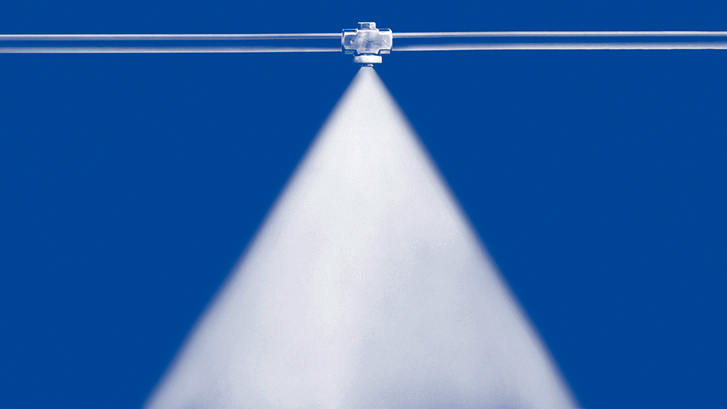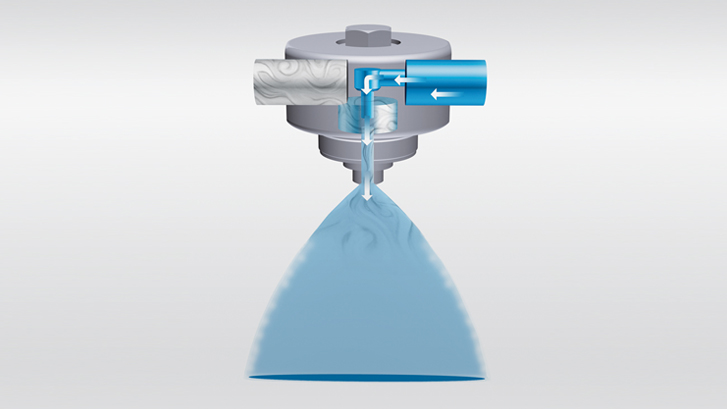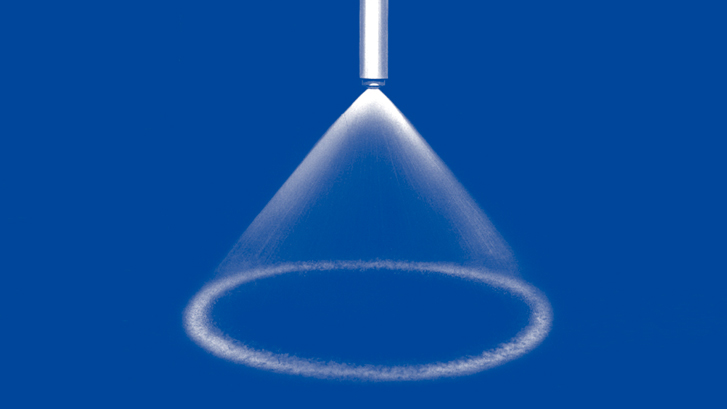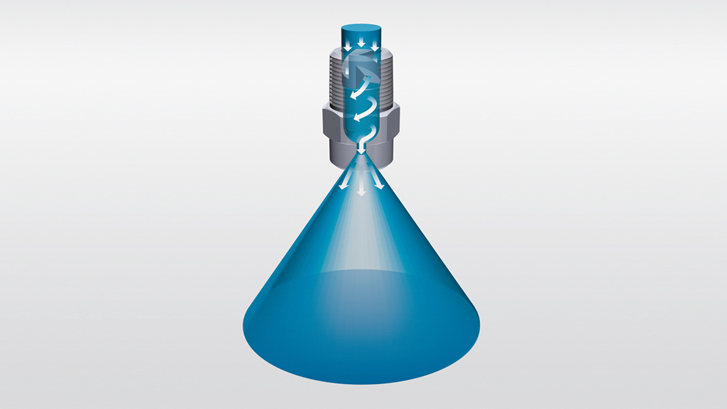Spray Character
Which spray character suits best to you?
In addition to the classification by atomization principles, the various nozzles are also classified by their spray patterns. The following summary gives you a survey on this subject.
Pneumatic atomization

Pneumatic flat spray atomization
Pneumatic flat fan atomizing nozzles produce a flat spray pattern with extremely fine droplets and spray angles up to 80°. These nozzles are particularly suited for applications requiring fine droplets and a wide linear impact.

Pneumatic full cone atomization
Pneumatic full cone atomizing nozzles are preferably used for applications demanding uniform circular impact patterns or larger spray distances. Generally, a narrow full cone with approx. 20° – 30° is formed. Wider spray angles can be achieved by using special multi-orifice designs.
Hollow cone spray

Axial-flow hollow cone spray
With this nozzles, the liquid supply is axial. Rotary motion of the liquid is generated by so-called swirl inserts or vanes. Axial-flow hollow cone nozzles allow to produce the finest droplets achievable with pressure-operated nozzle designs. This is also called hydraulic atomization.

Eccentric-flow hollow cone spray
Eccentric-flow hollow cone nozzles The liquid supply, which is tangentially positioned to the mixing chamber, causes the liquid to rotate. A liquid layer forms around the inside walls of the nozzle which influences heavily the drop size. A rotary motion of the liquid flow is transformed at the nozzle orifice into axial and tangential speeds. A circular liquid screen is formed which disintegrates into fine droplets soon after leaving the nozzle orifice. This nozzle design has wide free cross-sections making it highly clog-proof.
Full cone spray

Axial-flow full cone spray
Axial-flow full cone nozzles achieve a uniform liquid distribution over a circular area. A rotary motion of the liquid is achieved with the aid of swirl inserts inside the free cross-section of the nozzle. Spray formation, liquid distribution, and shaping of droplets are influenced by the dimensioning and functional coordination of the rotary motions and the swirl chamber. Turbulent flows with different axial and tangential speed components lead to overall coarser droplets than with a comparable hollow cone nozzle.

Tangential-flow full cone spray
Tangential-flow full cone nozzles are free from swirl inserts. Therefore, they are not at all prone to clogging. The full cone spray pattern is produced by grooves milled into the bottom of the nozzle which provide a defined deviation of the liquid flow to the mixing chamber’s center, whereby an extremely uniform area distribution of the atomized liquid is obtained.
Flat fan spray
Flat fan spray atomization with flat fan nozzles
The spray pattern of flat fan nozzles features a sharply delimited line due to internal flow characteristics. The coverage width can be varied by modifying the geometric configuration of the nozzle orifices, where the liquid is shaped into flat, fan-like spray patterns. The flat liquid body takes on a laminar form and disintegrates into droplets as its distance from the nozzle orifice increases. Parabolic, trapezoidal or rectangular impact areas are achieved by adequately determining the functional and geometric dimensions.

Flat fan spray atomization with tongue-type nozzles
Regarding the flat fan spray atomization, tongue-type nozzles are of a special kind. The flat fan pattern is generated by a solid stream, impinging upon an external deflector plate (“the tongue”). Tongue-type nozzles are particularly clog-proof and produce a sharply delimited flat fan pattern.
Solid stream

Without atomization in a solid stream
The smooth solid stream is also known as the so-called “primary jet”. Actually, the solid stream nozzle is not supposed to produce an atomized spray pattern, because it has been designed for maximum jet power. Here, the skill of Lechler design engineers was challenged to prevent concentrated, straight jets from disintegrating into drops at large distances.
Dispersion of compressed air
Plane or punctual dispersion of compressed air
Air nozzles are used for dispersing air or steam in a concentrated and straight fan. Generally, air nozzles have a flat fan or solid stream spray pattern. When using conventional air nozzles, air is blown through a single hole. Often a loud, ear-splitting and hissing noise is produced. To avoid this unpleasant noise, Lechler has designed special multi-channel air nozzles. Sound level and air consumption of these nozzles are very low.
Atomization for tank cleaning

Atomization by rotating nozzles
Tank cleaning nozzles can be used for both small and large tanks and are available as both rotating and static sprays. The rotating nozzles (rotational cleaners) are driven by the cleaning liquid by means of specially positioned nozzles or by turbine or internal gears. Rotational cleaners achieve very good cleaning of the entire tank surface as rapid-repetition impact loosens the dirt and washes it off of the inside tank surfaces.

Atomization by static spray balls
Static spray balls do not rotate. They are used primarily for washing down relatively small tanks and vessels. All tank cleaning nozzles are operating at low pressures.

